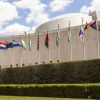About 700 projects in Asia alone
The Cultural Preservation Programme of the Federal Foreign Office provides support for the preservation of cultural heritage abroad and brings together countries and people.

The Kathmandu Valley in Nepal is one of the most significant regions in the world in terms of cultural heritage. Exquisite temples and palaces once occupied by kings are among the total of seven World Heritage Sites at the foothills of the Himalayas. Since 1981, the Federal Foreign Office has been supporting the preservation of cultural heritage across the globe as part of its Cultural Preservation Programme. In Nepal, one of the projects in recent years was restoration work at the Patan Royal Palace Complex. Many of the centuries old cultural sites were destroyed during the devastating earthquakes in April and May 2015. Countless historically significant monuments in Nepal were damaged or completely destroyed. In a joint initiative with the Gerda Henkel Foundation, the Federal Foreign Office provided aid for reconstruction work immediately after the disaster. Work was already underway on the site at the Patan Royal Palace in Autumn 2015. The Sundari Chok fountain in the courtyard of the southern section and the Bhandarkhal water tank underwent restoration from 2008 as part of the Cultural Preservation Project, and later the south wing and the rear courtyard. Whilst these parts of the building withstood the natural disaster, the Palace’s east wing completed collapsed. Sections that had already been restored were earthquake-proofed, as sustainable reconstruction is an essential focus of the Cultural Preservation Programme. This is evident too in the reconstruction of the courtyard façade: the parts salvaged from the ruins were all reused. Work on this part of the complex should be finished by January 2017.
In Asia alone, about 700 projects have received support for the preservation of cultural heritage. Current examples are projects to preserve wall paintings at Vat Sisaket in Vientiane, Laos, and preservation of the Angkor Wat temple complex in Cambodia. The aim is to strengthen awareness in the partner country of its own national identity and to promote a cultural dialogue in the spirit of partnership. Around 65 million euros were provided between 1981 and 2015 to fund more than 2,700 projects in 144 countries throughout the world. The Cultural Preservation Programme covers a wide range of activities, including restoring historical buildings, artefacts and manuscripts, supporting and equipping museums, making documentaries or films and recording oral traditions in literature and music. One trend is the digitalisation of historical documents or cultural sites, which has become much more important in recent years. In Sri Lanka, researchers from the University of Bamberg are working with colleagues from Sri Lanka’s University of Kelaniya on the survey and 3D-digitalisation of the main section of the Temple of the Tooth in Kandy. This significant Buddhist pilgrimage site was badly damaged during a terrorist attack in 1998. Tradition has it that the left upper canine of the Lord Buddha is found in the Temple of the Tooth. This cultural preservation project will preserve the Temple for future generations. The general public will also have access to this cultural site by way of virtual tours over the Internet.
The projects included in the Cultural Preservation Programme are all developed in close dialogue with partners in the country in question and, where possible, implemented in cooperation with local experts and restorers. Hans Leisen, professor emeritus of the University of Applied Sciences in Cologne, says: “Training is a very important aspect for us, from which both sides benefit.” The geologist and conservation expert has been project manager since 1995 in Angkor, Ayutthaya in Thailand and Borobudur in Central Java. About 130 students from Germany and Asia have been able to put their knowledge into practice in the programme. “They develop their own concepts, which they test out directly on site,” says Leisen. Practical heritage preservation can be implemented very well in these projects. “This form of cooperation has also given me as teacher great motivation throughout the years.” The temple city of Angkor, a compound with an endless number of large and small temples, was one of the most important centres of Khmer civilisation and today is one of Southeast Asia’s major tourist attractions. With financial support from the Federal Foreign Office, a team from the University of Applied Sciences in Cologne led by Professor Leisen, is restoring the many reliefs in the middle of the Cambodian jungle. The apprenticeship and further training of local restorers and German students in the preservation of stone, stucco and brick was from the outset an essential component of the project.
“We maintain the structures as they are,” emphasises project manager Hans Leisen. His team works closely with scientists, architects and archaeologists from within the country and abroad. Many of the famous sandstone reliefs with the images of Apsara dancers are so weathered that there are only remnants left. Not all of them can be saved. More than one third of the total of 1,850 images were so damaged when conservation work started that large portions were lost every day in the initial years. “We first did emergency preservation work on many reliefs in order to protect visitors,” Leisen says. The monument conservators and restorers have now successfully completed more than one thousand of the Apsaras engraved in stone. The commitment of the German scientists is regarded extremely positively, Leisen notes. “The Cultural Preservation Programme is a diplomatic door-opener.” Working together across eras, regions and materials, interdisciplinary teams are saving historically unique cultural treasures and assets from decay, providing training, integrating local specialists and thus strengthening the regional economy. For Hans Leisen, who has been working in Asia for more than twenty years in the honorary capacity of “temple doctor”, this is a successful concept. “Helping people to help themselves.” ▪

